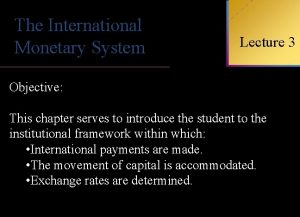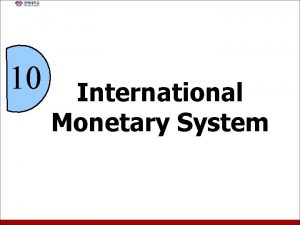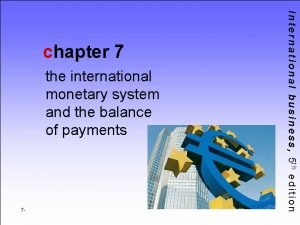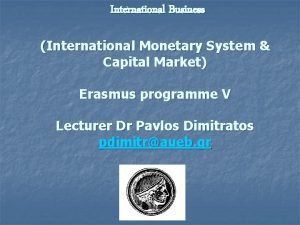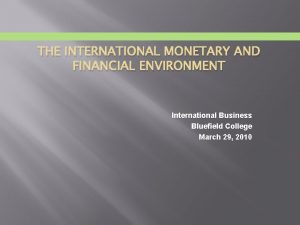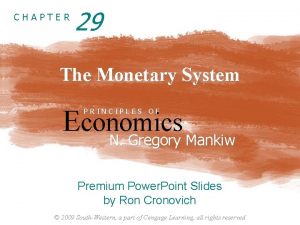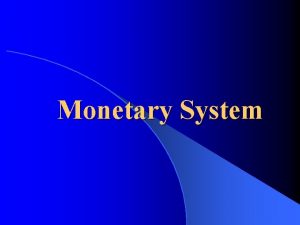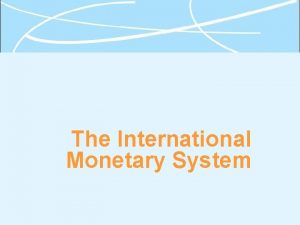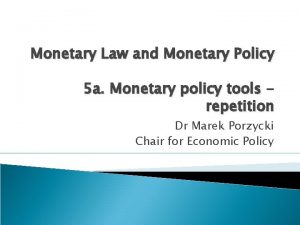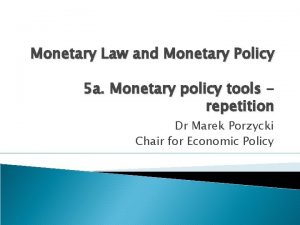International Monetary System IMS n Structure of IMS









- Slides: 9

International Monetary System IMS n Structure of IMS: Framework within which the foreign Exchange rates are determined, capital flows & international trade are accommodated & Balance of Payments Adjustments are made n History of IMS: The Gold Standard (1876 -1913): Ÿ Gold as a medium of exchange- Pharaohs (3000 PC) Ÿ The Greeks, Romans & Persians Used gold coins & passed through the mercantile era to the 19 th century Ÿ No multinational agreement, but each country declared a par value for its currency in terms of gold based on rule of games or "Gold Standard" MENU

International Monetary System IMS-cont. . n Mercantilism of 19 th Century: Need for IMS: Ÿ Europe adapted the IMS in 1870 & the U. S. . in 1879 Ÿ $20. 67/Ounce of Gold, £ 4. 274/Ounce: Ÿ $20. 67/£ 4. 2474=£ 4. 8665/$ Ÿ Limitation of gold reserve & supply of money Ÿ Limit the flow of goods and gold & suspension of GS n Inter War Years: 1914 -1944: Ÿ Free Fluctuating of Exchange Rates with consideration of the gold and par value of other currencies. Ÿ Short sell of week currencies, re-evaluation of £, the collapse of the Austrian banking system-total abandonment of GS MENU

International Monetary System IMS-cont. . n The Bretton Wood Agreement: (1944) Ÿ Dollar based Monetary System (par value based on $) Ÿ Fixed value in term of $, but not required to convert Ÿ Only $ remained convertible to gold: $35/Ounce Ÿ Only 1% of par allowed for fluctuation Ÿ Devaluation was not allowed for purpose of high export Ÿ 10% devaluation for week currency or approval of IMF Ÿ IMF & World Bank were created Ÿ Former Soviet Union did participate at Bretton Wood but chose not to join IMF or World Bank MENU

International Monetary System IMS-cont. . n International Monetary Fund IMF: Ÿ Mission: Rendering temporary assistance to currencies with cyclical, seasonal or random fluctuation. Ÿ Help countries with a structural trade problem Ÿ IMF is funded based on quota of expected post WWII trade Ÿ The Original quota were 25% in gold or $ (Gold tranche), & 75% local currency. Ÿ A member country can borrow up to its original 25% in gold or convertible currencies in any 12 month plus 100% of its total quota. A member country can also borrow up to 120% of its quota in convertible currency or gold, even through it only paid 25% in convertible currency or gold. MENU

n International Monetary System IMS-cont. . International Monetary Fund IMF Cont. . : Ÿ At the present time, each of the 151 member can borrow up to 150% annually of its quota or up to 450% during a three years period Ÿ Cumulative access could be up to 600% of members quota Ÿ Distribution of the quota is prelude to distribution of vote Ÿ U. S. Vote: 19. 1%, UK: 6. 6%, Germany: 5. 8%, France: 4. 8%, Japan: 4. 5%, Canada: 3. 2% Ÿ General Agreement to Borrow: IMF ability to borrow from member countries, currently more than $180 billion. Ÿ Special Drawing Rights (SDR): created according to Rio de Janeiro agreement (1967) to help increase the global trade between nations Ÿ SDR is distributed based on members quota and valued based on 16 then 5 currency Ÿ First $/SDR determined then value of other currencies are measured MENU

International Monetary System IMS-cont. . n Monetary Development: (1944 -1971) Ÿ EFTA (1957) & EEC (1959), rapid increase in world trade Ÿ U. S. . deficit of 1959 & International Monetary Reserve dilemma: BOP deficit to create more reserve for LDCs Ÿ Doubt of convertibility of major reserve currencies Ÿ "Interest Equalization Tax"on foreign borrowing & creation of Euro-bond Ÿ Mandatory control of direct foreign investment , control of foreign lending by U. S banks, & high U. S deficit Ÿ official Currency Swaps: Group of Ten Industrialized Nations as a interest credit between central banks MENU

n International Monetary System IMS-cont. . Floating Exchange Rate-Crises of 1971: Ÿ U. S. BOT had reached to all-time high in 1971 Ÿ U. S lost one-third of her official gold & president Nixon suspended convertibility of $ to gold Ÿ U. S. imposed 10%surcharge on imports & freezed P&W Ÿ Most European currencies gained against $ n Smithsonian agreement: December of 1971 Ÿ Group ten Industrialized Nations signed on Dec, 17 1971 Ÿ $ devaluated to $38/Ounce, Yen evaluated against $ : 16. 9%, Canada 7. 4% Ÿ Floatation of 2. 25% (Max 4. 5%) is allowed Ÿ $ lost its value sharply: $42. 22 in free market, $70 in official London market MENU

International Monetary System IMS-cont. . n Jamaican Agreement: January 1976 Ÿ Floating Rate has been established ( has continued today) Ÿ Gold was demonetarized as a reserved asset Ÿ IMF agreed to sell $25 million ounces of gold to its members and used the proceeds to help the poor nations Ÿ IMF quota increased to $41 and then to $180 billion Ÿ 10% of the voting power given to OPEC members Ÿ Non-oil producing countries have more access to IMF Ÿ Floating Exchange Rate System has officially adopted & continued until present time MENU

International Monetary System IMS-cont. . • Plaza Agreement • Louvre Agreement http: //www. econ. iastate. edu/classes/econ 355/choi/cur. htm END MENU
 International monetary system
International monetary system Objectives of international monetary system
Objectives of international monetary system International monetary system
International monetary system International monetary system
International monetary system International monetary fund apush
International monetary fund apush International monetary and financial environment
International monetary and financial environment International monetary and financial environment
International monetary and financial environment International monetary fund
International monetary fund International monetary fund
International monetary fund Chapter 29 the monetary system
Chapter 29 the monetary system
